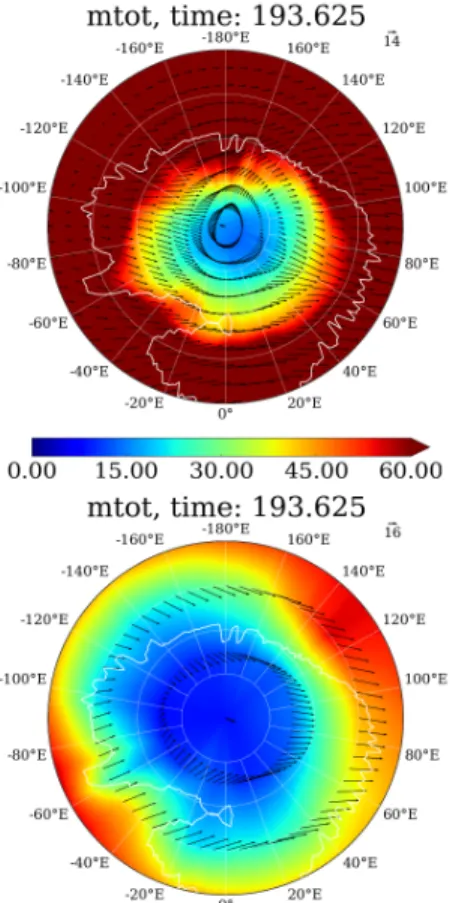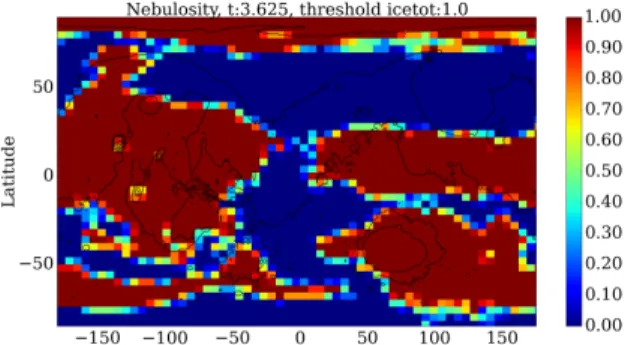HAL Id: insu-01217131
https://hal-insu.archives-ouvertes.fr/insu-01217131
Submitted on 20 Oct 2015
HAL is a multi-disciplinary open access
archive for the deposit and dissemination of
sci-entific research documents, whether they are
pub-lished or not. The documents may come from
teaching and research institutions in France or
abroad, or from public or private research centers.
L’archive ouverte pluridisciplinaire HAL, est
destinée au dépôt et à la diffusion de documents
scientifiques de niveau recherche, publiés ou non,
émanant des établissements d’enseignement et de
recherche français ou étrangers, des laboratoires
publics ou privés.
A high resolution study of the Martian water cycle with
a global climate model
Alizée Pottier, Franck Montmessin, François Forget, Thomas Navarro,
Ehouarn Millour, Jean-Baptiste Madeleine, Aymeric Spiga
To cite this version:
Alizée Pottier, Franck Montmessin, François Forget, Thomas Navarro, Ehouarn Millour, et al.. A high
resolution study of the Martian water cycle with a global climate model. European Planetary Science
Congress 2015, Sep 2015, Nantes, France. pp.EPSC2015-215. �insu-01217131�
A high resolution study of the Martian water cycle with a
global climate model
A. Pottier (1), F. Montmessin (1), F. Forget (2), T. Navarro (2), E. Millour (2), J.-B. Madeleine (2), A. Spiga (2),
(1) Laboratoire Atmosphères, Milieux, Observations Spatiales, Guyancourt, France (2) Laboratoire de Météorologie Dynamique, Université Pierre et Marie Curie, Paris, France (alizee.pottier@latmos.ipsl.fr)
Abstract
The martian water cycle's main source is the northern polar cap. Running high resolution models, up to 360° per 180°, help better resolve this ice cap, and better mimic the gradual retreat of the seasonal cap. Atmospheric circulation is also better resolved. Water vapor advection and the subsequent formation of clouds quite differ when we compare these brand new high resolution simulations and the usual lower resolution ones at 64 per 48 grid points.
1. Introduction
On Mars, there is no liquid water in present time, even if geological evidence of it exists. The planet is a cold, dry desert. Yet, there is still a water cycle. Its main source is the northern polar ice cap : the perennial one is indeed mainly composed of water ice which is exposed in summer and fuels the water cycle. Water ice frost was observed during the retreat of the seasonal cap[1] below the dry ice and mixed with it. While a significant part of the atmosphere condenses in winter at the poles, it traps water vapor that can be released in the subsequent warmer season. The martian global climate model (GCM) used in this study was developed in the LMD laboratory over the course of many years. Radiatively active water ice clouds were recently included, that make the temperature profiles agree more with observations[2]. There is a new microphysical scheme of growth of clouds over dust particles[4]. The model is now able to simulate the observed supersaturation[3]. The northern polar hood now vanishes in summer[5].
2. High resolution model
A set of models was run to unravel new phenomena to be seen with this increased resolution. Standard models are run on a 64 per 48 grid. The new, higher resolution grid is made up of 360 per 180 points. The
height levels are the same, 29 ranging from the ground to around 100 km. Runs with and without clouds that are radiatively active were computed, to be able to understand better the physical origin of the observed effects on climate and the water cycle.
3. Results
The advection of the water vapor sublimated from the northern seasonal cap in summer when the polar hood disappears is visibly changed, as can be seen on figure 1.
Figure 1: Total vapor column and a sample of wind vectors at 8 km over the north polar cap, summer solstice. Up: high resolution, down: low resolution. EPSC Abstracts
Vol. 10, EPSC2015-215, 2015
European Planetary Science Congress 2015 c
Figure 2: Spiralling clouds, Ls=150°
There are also significant differences in waves in the high resolution runs. The active clouds seem to be one of the triggers of these waves. The study is ongoing.
One effect of the better resolution is interesting spiralling clouds during the dust storm season, or earlier, like on figure 2 which shows cloud column and a sample of the wind vectors for clarity.
4. Validation of a new
parametrisation
High resolution model runs can also help validate new parametrisations. An example is the inclusion of a subgrid scale temperature distribution, which allows to compute partial cloudiness in the model. Rebinning high resolution runs, a cloudiness diagnosis may be made to compare with new parametrisation models. On figure 3, the aphelion cloud belt of clouds at low latitudes (between -10° and 30°) is visible, and partially cloudy at its edge.
Figure 3: Partial cloudiness, high resolution model, threshold on ice cloud column: 1 pr. μm, Ls=90°
5. Conclusions and perspectives
The study of these high resolution simulations with the LMD GCM helps uncover new dynamical phenomena. These are linked to interesting cloud patterns and even some spiralling clouds. New insights into the fascinating water cycle of the red, desert planet will be allowed. Watching the clouds and advected vapor swirling in high resolution is very interesting and opens new opportunities of study.
The next step will be the improvement of the regolith water adsorption scheme and the frost representation. Combined with the power of high resolution modelling, they might help understand the water cycle of Mars even better.
Acknowledgements
Thanks to René Ernenwein and Jérémy Foulon who provided advice to optimise the model runs on the Mesu supercomputer.
References
[1] Langevin, Y., Poulet, F., Bibring, J.-P., Schmitt B., Douté, S., and Gondet, B.: Summer evolution of the north polar cap of Mars as observed by OMEGA/Mars Express, Science, vol. 307(5715), pp. 1581-4, 2005.
[2] Madeleine, J.-B, Forget, F., Millour, E., Navarro, T., and Spiga, A.: The influence of radiatively active water ice clouds on the Martian climate, Geophys. Res. Lett., 39, 2012.
[3] Maltagliati, L., Montmessin, F., Fedorova, A., Korablev, O., Forget, F., and Bertaux, J.-L.: Evidence of Water Vapor in Excess of Saturation in the Atmosphere of Mars, Science, 333, 1868-1870, 2011.
[4] Montmessin, F., Rannou, P., and Cabane, M.: New insights into Martian dust distribution and water-ice cloud microphysics, JGR., 107, 2002.
[5] Navarro, T., Madeleine, J.-B., Forget, F., Spiga, A., Millour, E., Montmessin, F., and Määttänen, A.: Global climate modeling of the Martian water cycle with improved microphysics and radiatively active water ice clouds, JGR : Planets, 119, 2014.

